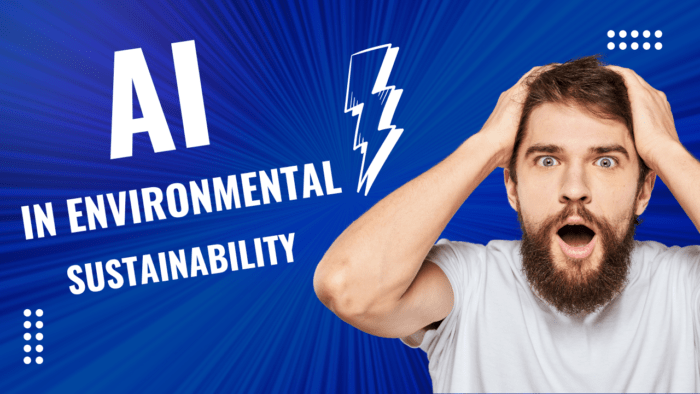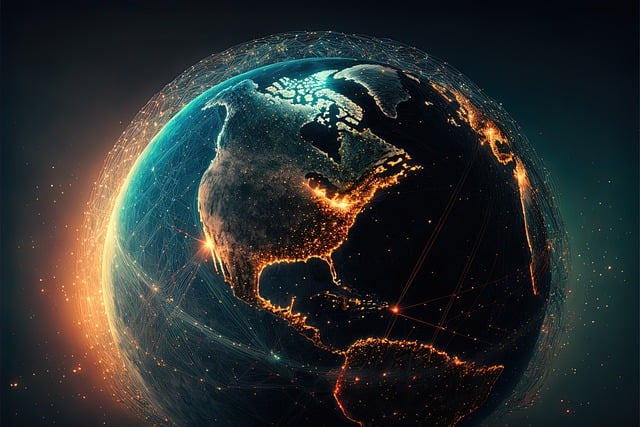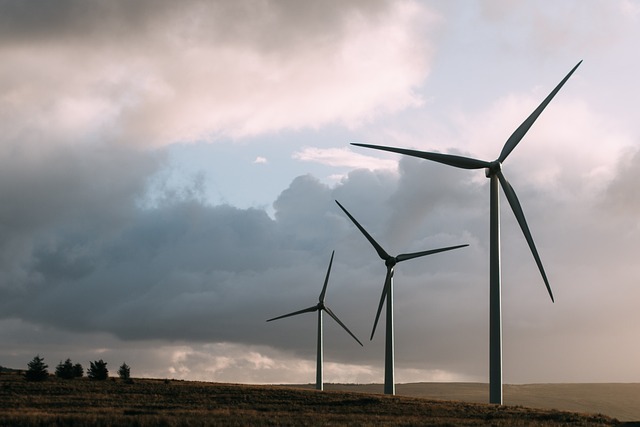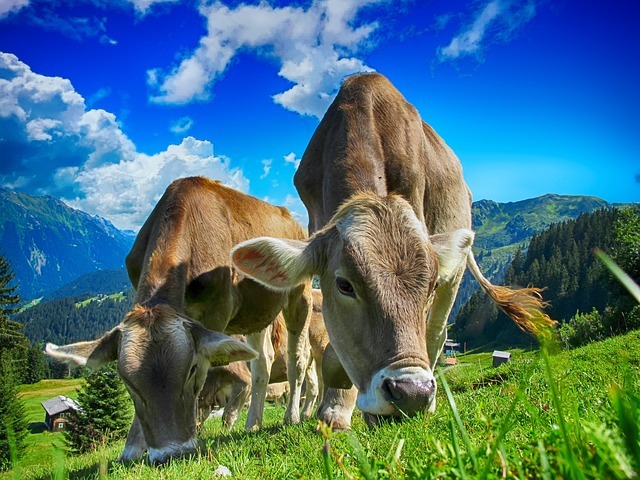AI in Environmental Sustainability: Comprehensive Overview of Trends and Technologies for 2025

Discover how AI in environmental sustainability 2025. Explore cutting-edge trends and technologies in climate prediction, renewable energy, waste management, and more.
Introduction
🌍Did you know that global temperatures have risen by 1.2°C over the last century, and if we don’t act now, they could rise by as much as 3-5°C by 2100?

With environmental challenges like climate change, deforestation, and waste management growing more urgent, the world needs innovative solutions. Enter Artificial Intelligence (AI)—a game-changer in tackling these crises head-on.

👉 Join our Telegram community
AI is no longer a futuristic technology reserved for tech companies; it’s now a cornerstone of efforts to make our planet greener and more sustainable. This article explores the role of AI in environmental sustainability, diving deep into its applications, from climate prediction to renewable energy optimization. Let’s take a comprehensive look at how AI is making a positive impact on the environment.
The Evolution of AI in Environmental Sustainability
AI’s journey from a niche technology to a vital component of environmental protection is remarkable.
Brief History of AI in Environmental Science
The idea of using technology to address environmental issues dates back to the 1970s, but AI’s influence really started gaining momentum in the early 2000s. Technologies like machine learning (ML) and neural networks opened new doors for climate science and sustainability efforts.

Key Milestones
- 2006: The first AI model designed for environmental monitoring launched.
- 2015: AI played a critical role in analyzing climate change data in the lead-up to the Paris Agreement.
- 2022: AI-powered precision agriculture helped boost crop yields by 25% globally.
Today, AI is deeply integrated into various environmental applications, setting the stage for even more breakthroughs in 2025.
AI-Powered Climate Change Prediction and Modeling
Climate change is one of the most pressing challenges of our time, and AI is at the forefront of predicting and modeling its impacts.
Advanced Machine Learning Algorithms for Climate Modeling
Using advanced machine learning techniques, AI can simulate complex environmental systems. These models are not only more accurate but also faster than traditional climate models. AI can process vast amounts of environmental data, identifying patterns humans would miss.
Improved Accuracy in Predicting Extreme Weather Events
Thanks to AI, weather prediction models are becoming more accurate, allowing for better preparedness against hurricanes, floods, and heatwaves. For example, deep learning models can now predict heatwaves months in advance, giving authorities time to take preventive measures.
AI-Driven Climate Risk Assessment for Businesses and Governments
Corporations and governments are increasingly leveraging AI for climate risk assessments, allowing them to evaluate potential environmental threats and adapt their strategies accordingly. This is critical for industries that rely heavily on environmental conditions, like agriculture and energy.
Revolutionizing Renewable Energy with AI
The shift to renewable energy is essential for a sustainable future, and AI is optimizing every aspect of this transition.

AI Optimization of Smart Grids and Energy Distribution
Smart grids use AI algorithms to optimize energy distribution, ensuring that renewable energy sources like solar and wind are efficiently used. AI can predict energy demand and automatically adjust the grid to maintain balance, reducing energy waste.
| Key Benefits of AI in Smart Grids | Description |
|---|---|
| Predictive Maintenance | AI can identify potential issues before they cause outages, reducing downtime. |
| Energy Demand Forecasting | AI predicts consumption patterns, ensuring that renewable energy sources are maximized. |
Predictive Maintenance for Renewable Energy Infrastructure
AI-powered sensors monitor wind turbines and solar panels, predicting when maintenance is needed. This prevents costly failures and extends the lifespan of renewable energy assets.
AI-Driven Energy Storage Solutions

👉 Join our Telegram community
Energy storage is one of the major challenges in renewable energy. AI is revolutionizing battery technology by improving storage capacity and efficiency, ensuring that excess energy generated from renewables can be stored for later use.
AI in Waste Management and Recycling

Managing waste effectively is a crucial part of environmental sustainability, and AI is streamlining this process.
Intelligent Sorting Systems for Efficient Recycling
AI-powered robots are being used in waste management facilities to sort recyclables with high precision. These machines use computer vision to identify materials like plastics, metals, and paper, automating the recycling process.
AI-Powered Waste Reduction Strategies
AI is also helping reduce waste at its source. By analyzing consumption patterns, businesses can better forecast demand, minimizing overproduction and waste.
Innovations in Biodegradable Materials Development
AI is contributing to the development of biodegradable materials by simulating different chemical compositions and testing their environmental impact. This accelerates the development of eco-friendly alternatives to plastics.
Sustainable Agriculture and AI

With the world’s population growing, sustainable agriculture is more important than ever. AI is revolutionizing farming with precision agriculture.
Precision Farming Techniques Using AI and IoT
AI, combined with IoT (Internet of Things) devices, is enabling precision farming, where farmers use data-driven insights to optimize crop production. This reduces the use of water, fertilizers, and pesticides, making agriculture more sustainable.
AI-Driven Crop Yield Prediction and Optimization
AI algorithms can analyze soil conditions, weather forecasts, and past yields to predict crop outcomes with high accuracy. This allows farmers to make data-driven decisions that improve productivity.
Smart Irrigation Systems and Water Conservation in Agriculture
Smart irrigation systems, powered by AI, ensure that crops get the right amount of water at the right time, reducing water waste and promoting better crop growth.
AI for Wildlife Conservation and Biodiversity

AI is also making a significant impact on wildlife conservation efforts.
AI-Powered Species Identification and Tracking
Using AI, conservationists can track endangered species and monitor their habitats. AI-powered drones, for instance, can fly over forests to track animals and capture data that would take humans much longer to gather.
Predictive Modeling for Habitat Preservation
AI models can predict how environmental changes will affect specific ecosystems, helping authorities take steps to preserve critical habitats.
Combating Illegal Poaching and Wildlife Trafficking Using AI
AI is being used to track poachers in real-time through remote sensors and camera traps. These systems can alert authorities to suspicious activities, helping combat illegal wildlife trafficking.
AI in Sustainable Urban Planning and Smart Cities

Cities are responsible for a large portion of global emissions. AI is helping make urban areas more sustainable.
Optimizing Transportation Systems to Reduce Emissions
AI-powered systems optimize public transportation schedules and routes, reducing traffic congestion and emissions. In some cities, AI is also being used to create intelligent transportation systems that monitor and adjust traffic in real-time.
AI-Driven Energy-Efficient Building Design and Management
AI is helping architects design energy-efficient buildings that minimize energy consumption. Smart systems within buildings can also adjust lighting, heating, and cooling based on occupancy, further reducing energy use.
Conclusion

AI’s role in environmental sustainability is growing by the day. From predicting climate changes to optimizing renewable energy and enhancing waste management, the technology is helping us address the most critical environmental challenges of our time. The trends and technologies discussed in this article are just the beginning. As we look toward 2025 and beyond, AI’s potential to revolutionize our approach to sustainability is limitless.
Table of Contents
It’s up to businesses, governments, and individuals to embrace these innovations and work together for a greener, more sustainable future. 🌱 Ready to join the movement? Share your thoughts or experiences in the comments below!

👉 Join our Telegram community
- 5 Best Credit Cards in India 2025: Unlock Rewards & Save More!
- 7 Smart Tips to Overcome EMIs Higher Than Your Salary in India (2025)!
- High EMI or Low EMI for Your Home: What’s the Best Choice in India (2025)?
- Car vs House: What Should You Buy on a ₹30K Salary in India? Smart Choices for 2025!
- Living on a ₹30,000 Salary in India (2025): Expert Budgeting Tips to Save & Thrive









Howdy very cool blog!! Guy .. Beautiful .. Superb .. I’ll bookmark your blog and take the feeds additionally…I am satisfied to search out so many helpful information right here within the post, we’d like develop extra techniques on this regard, thank you for sharing.
For more superior fat loss and muscle features, some
women will stack HGH with Anavar, which is considered essentially the most female-friendly steroid.
In Distinction To some steroids that can trigger spikes
in starvation, trenbolone retains users
feeling full for longer periods of time, making it easier to maximize calorie consumption and achieve lean muscle mass.
New customers and extra experienced customers alike can anticipate to see significant
positive aspects in strength throughout all lifts and
large will increase in lean muscle mass, hardness and definition. In summary, legal steroid alternate options like CrazyBulk Trenorol can be a
secure and efficient various to Trenbolone for bodybuilders looking to build muscle,
improve power, and enhance performance. With pure ingredients
and scientific evidence to support their effectiveness, legal steroid alternatives could be a welcome addition to your bodybuilding routine.
Trenorol is a legal steroid alternative to Trenbolone, which is the steroid that this weblog submit discusses.
Testosterone manufacturing will be shut down, and this will proceed properly after your cycle ends because of the
longer-lasting metabolites that this steroid leaves within the body.
You ought to plan to proceed with TRT or Testosterone cruising once
you’re carried out with a Tren cycle. Whatever you choose to stack Trenbolone with, including Testosterone as a base,
is necessary to avoid complete sexual dysfunction. Bulking, recomp, cutting, power – Trenbolone is so versatile that you’ll
use it in almost any stack. There isn’t any shortage of adverse
feedback about Tren cycles, though sometimes, this will
consist of men just speaking about a few of the worst unwanted side effects and tips on how to manage them.
Some extra unfavorable critiques naturally heart on Tren’s tendency to have an result on your psychological
functioning.
This will allow you to make informed decisions regarding
dosage, period of use, and post-cycle therapy (PCT) to reduce potential dangers.
Equally, customers could choose to undertake a ketogenic food regimen when cycling trenbolone, which can present even higher cardioprotective effects
(1). To enter a ketogenic state, customers should purpose for 30 grams of
carbohydrates or less per day. A ketogenic diet may even enhance subcutaneous and visceral fats loss, which is advantageous for bodybuilders.
Tren could cause massive breakouts of zits, especially on the back,
oily pores and skin and elevated progress in body and facial hair.
There can be the potential of progesterone rising which might cause gynecomastia.
As A Substitute, if a consumer is troubled by hair loss,
we encourage them to keep away from androgenic steroids.
It has been acknowledged to produce glorious bodybuilding results and is doubtless
one of the high compounds for bodybuilders on the lookout for a great chopping steroid.
It is predominantly utilized in chopping cycles, because of its fat-burning results.
Winstrol burns fats by slashing cortisol ranges,
the hormone liable for cussed fats storage. Before you take winstrol make sure your levels of
cholesterol are healthy and your LDL scores aren’t too high.
This is as a outcome of winstrol will almost
definitely spike these adverse cholesterol levels, which can increase your blood stress.
This is a constructive thing, however, bodybuilders must
be careful about overtraining in the course of the first few Trenbolone cycles to offer the muscles/tendons time to adapt.
In Any Other Case, the fast increase in power will make
the body extra vulnerable to damage. Other anabolic steroids, such as Dianabol,
Winstrol, and Anavar, may even pose fewer dangers; nevertheless, due to their oral
nature, they will cause extra inflammation in the liver.
Customers will typically be shut down after a cycle, taking their natural testosterone manufacturing several months to revive again to
regular levels. However if you’re unhealthy to start with, taking winstrol among different anabolic steroids can turn out to be harmful.
If you go longer than that, you would possibly be risking excessively high LDL cholesterol levels.
One of one of the best attributes of winstrol, is that the load gained on this steroid is type of
one hundred pc lean muscle mass. Trenbolone’s interplay with androgen receptors
defines its organic activity and potent anabolic results. These receptors, part of the nuclear
receptor superfamily, mediate steroid hormones, facilitating physiological processes.
Trenbolone’s distinctive chemical structure
enhances its receptor-binding affinity, surpassing that of endogenous androgens like testosterone.
If so, you’ve likely heard of Trenbolone, a powerful anabolic steroid
that may assist you to construct muscle, burn fats, and increase your power.
Nevertheless, it’s important to make use of Trenbolone correctly and safely to keep away from any unfavorable side effects.
Technically, the physique does not aromatize parabolans, therefore not increasing estrogen ranges.
The lack of ability to climax and weaker, softer
erections are also linked to elevated progesterone. Utilizing
substances like cabergoline can help decrease and halt these symptoms
should you experience them. Parabolan unwanted aspect effects can take
many forms and are typically extra common in users of prolonged cycles or
larger dosages. Steroids’ opposed effects may include an estrogenic, androgenic part and cardiovascular
penalties.
Additionally, Deca Durabolin raises prolactin ranges, a lactating hormone
that may decrease arousal or sexual curiosity. Furthermore, when Deca Durabolin is stacked with other steroids, we find customers continue to experience results in the
latter levels of a cycle. In comparison, other AAS can peak early
or trigger more unwanted facet effects than benefits
in course of the end of a cycle because of high levels of toxicity.
This signifies that it can be injected less regularly than Trenbolone Acetate.
Though a substantial amount of info could be found online about trenbolone, you have to be very careful about what you accept as truth.
Those who use tren will each have their own opinions and impressions
and those are sometimes only partially knowledgeable – or
worse, mis-informed. With the Internet basically erasing borders, nonetheless,
there are heaps of substances that could be acquired
on-line, even in areas the place they’re prohibited.
The threat at all times exists that the quality of the product being provided may
be significantly decrease than promised. And then there’s the potential for getting swept up in a DEA
sting, should you’re in the U.S. Legal Guidelines from country to
country range broadly, from simply accessible over-the-counter in the UK to being illegal to
make use of or possess for human use within the US.
For a bulking cycle, Trenbolone can be stacked with different steroids such as Testosterone, Anavar, or Dianabol.
For a cutting cycle, Trenbolone can be stacked with Winstrol to
help burn fats and protect muscle. Many bodybuilders which
have utilized a huge selection of anabolic steroids contemplate tren to ship the most effective results, despite the very fact that it may carry harsh unwanted effects.
By binding strongly to androgen receptors, Trenbolone enhances protein synthesis and nitrogen retention within the muscles.
These processes are essential for muscle progress and recovery,
permitting athletes to expertise rapid muscle positive aspects and shorter restoration intervals between workouts.
Anabolic reactions, such as muscle protein synthesis,
build mobile parts and complex molecules; these reactions require energy enter
to proceed. This means buying options exterior our normal procedures
to buy nearly anything. It additionally means constantly being vigilant about
possessing and using Trenbolone because the penalties could be extreme.
In the US alone, potential giant fines and jail time are a real
possibility for anyone getting caught with Trenbolone or
other steroids. Optimistic Trenbolone reviews concentrate on how a
lot muscle has been gained and the way rapidly (expect it to be fairly
fast), strength features, and fat loss or body recomposition.
Tren-Max promotes nitrogen retention, and that’s the underlying mechanism for how it accelerates muscle growth
and helps burn fats while retaining muscle on a cutting
diet. There’s no water retention with Tren-Max, and you should
see considerably improved vascularity, which results in a defined and
exhausting physique that is so wanted by Trenbolone users.
References:
making your own steroids
Hey! Would you mind if I share your blog with my twitter group?
There’s a lot of people that I think would really enjoy your content.
Please let me know. Many thanks
Heya i am for the first time here. I came across this board and I find It really useful & it helped me out much. I hope to give something back and aid others like you helped me.
Woh I love your blog posts, saved to favorites! .
70918248
References:
female bodybuilding steroids (https://evansfunding.com/uncategorized/hello-world/)
You could certainly see your skills in the work you write. The world hopes for even more passionate writers like you who aren’t afraid to say how they believe. Always follow your heart.
Solely affordable to high rollers, Caesars Palace Online
casino slots online
and DraftKings On Line Casino are exceptions, with Stay Supplier
Blackjack tables that require a minimum wager
of $100 per hand. Well-bankrolled gamblers
can wager as a lot as $2,000 a spin on our prime high-stakes slot game.
IGT’s Simsala Spinn 2 pays 40x your initial bet when five wizards appear
on a payline. Nevertheless, the lion’s share of high-stakes slots has much decrease limits, usually in the $100-$500 range.
High-limit versions of in style slots are created exclusively for top rollers.
High-denomination slots give gamers an edge because they’ve the highest RTPs.
To encourage breaks and reduce steady play, casinos provide session limits that either remind players of elapsed time or automatically log them out after a set interval.
Quickest withdrawal casinos are known for processing
cashouts quickly, allowing you to entry your cash without unnecessary delays.
If you’re desperate to get your arms on your winnings, look for casinos that satisfaction themselves on swift payout times.
Studying evaluations and checking user feedback can provide
you insights into which casinos excel on this space.
In conclusion, Betway Casino excels as a high curler casino, providing an all-encompassing luxurious gaming
expertise. Its dedication to high-quality video
games, substantial bonuses, personalised service,
and stringent security measures make it a top choice for prime rollers worldwide.
These casinos present a VIP gaming expertise aimed toward supporting large deposits,
big bets, and large withdrawals. I reached the second tier after a couple of strong
deposits and immediately got access to a personal account supervisor.
From there, I started receiving unique reload bonuses and weekly cashback
presents. Their VIP casino mannequin doesn’t waste your time with gimmicks — the
rewards are actual, and so they arrive fast. If you’re into non-public
tables, personal service, and customized promos, you’ll feel the difference here.
I’ve performed blackjack and roulette with table limits as high as
$10,000 per round.
Right Here are the vital thing the reason why many US gamers need
to turn out to be a high roller. As of 2025, the online casinos thought-about one of the
best within the USA favored embrace Vegas Aces, Wild On Line Casino,
and Las Vegas USA. These platforms are praised for their beneficiant
promotions, giant number of video games, and dedication to secure, honest gaming experiences.
Players in non-regulated states can still partake within the excitement of on-line
gaming by way of social casinos. These platforms
permit you to play actual casino-style video games using digital tokens instead
of real cash. Whereas you won’t win money, you can take pleasure in quite a lot of video games in a fun, social setting.
Social casinos are perfect for informal players who need to expertise
the fun of online gambling with out the legal complexities.
James Reynolds Johnson is a seasoned skilled on the planet of online
casinos. With over 10 years of experience in the business, James has a wealth of
knowledge in regards to the latest on line casino games, tendencies, and technologies.
He has worked with some of the high on-line casinos in the world, offering professional evaluation and recommendation on every thing from recreation choice to fee methods.
James is keen about serving to gamers discover one of the best online casinos that provide truthful
games, glorious buyer assist, and generous bonuses. When he isn’t writing or researching, James
enjoys playing blackjack and poker. One method for players to
make sure they continue to be honest about their gameplay is by solely using reputable online websites that display info concerning accountable gaming insurance policies and procedures.
With slightly little bit of effort and dedication, each
participant can make sure they hold their betting habits underneath management while
nonetheless having fun on the tables.
Cashback is self-explanatory, and very like the rewards in your bank card purchases.
Yes, relying on the high roller on-line casinos, you can get a very generous bonus.
Continuos experience of enjoyable and pleasure esp to someone looking for journey in playing slots.
As you count on your credit shall be taken away and desires you to purchase then you’ll discover you’ll win and able to play once more.
The minimum guess for high-roller slots varies by sport and
casino, nevertheless it usually begins at $50 to $100 per spin.
Heidi’s Bier Haus is a well-liked slot series from WMS, so you’ll find a number of variations of the game.
“Comps” stands for “compensation,” meaning you obtain compensation whenever
you make high-volume bets.
Comps, or compensations, are rewards given by casinos to high rollers.
These can embody free lodge stays, meals, show tickets,
and other perks. The Venetian’s high curler slot parlors also function the power to request your favourite branded slots.
A high limit cashier cage assists the guests with questions and payouts.
The LED televisions are in every course, so you can watch your favourite show
or sporting occasion while playing the slots. Gentle & Surprise, which
is the brand new name of Scientific Games, also has a
sport called Huff ‘N Even More Puff Slots.
A high roller is a participant who deposits and bets significantly greater than average — typically $5,000 to $100,000+ — and qualifies for premium rewards, betting limits,
and personal VIP remedy. What units Luckyblock apart is its aggressive
200% welcome bonus as a lot as €25,000 – one of the highest I’ve seen – combined with a 15% weekly cashback program for $LBLOCK token customers.
Esports betting coupled with conventional on line casino games creates a high quality high-roller playground.
To turn into an internet high roller, you have to
persistently play exclusive excessive stake video games. There are a
number of prestigious programs which are supplied for high rollers solely.
If you make a critical amount of deposit or spend cash like insane, the casino will discover you and would want you to continue playing with them.
To hold you active, they’ll supply their out there excessive curler bonus rewards to you
so that you simply keep spending money on their casino. High curler slots are nice for players with huge bankrolls who want the fun of chasing the
most important jackpots.
Статья представляет разнообразные точки зрения на обсуждаемую тему и не принимает сторону.
They may lack correct knowledge safety measures, leaving your personal and financial information exposed to theft or misuse.
Additionally, these platforms frequently use misleading terms and circumstances that create unfair advantages for
the operator while disadvantaging players. As Soon As confirmed, your on line casino steadiness
will replace, and you can begin playing instantly. Navigate to the cashier part or wallet area
within your account dashboard to begin the deposit process.
As it turns out, legitimate casinos have particular attributes that the
shaky sites simply can not have. To start your check, have a glance at the
bottom of the app’s major show.
New gamers can play with out worrying about losing for their
first 24 hours of play. In reality, there were so many who it was difficult to scroll via all of them.
DraftKings Casino is the net on line casino version of the well-known DFS provider.
However, don’t write DraftKings off as simply a niche product provider.
There is a large diversity of bonuses obtainable through the
casino’s promotions page.
When assessing casinos that provide PayPal as a fee method, our team prioritizes safety
and security measures. We completely examine the encryption protocols and information safety practices
in place to safeguard gamers’ monetary data. Contemporary On Line Casino has made quite a splash in the online on line casino business, offering a
vibrant and interesting platform for players looking for thrilling gaming experiences.
As a relative newcomer, this casino has shortly established
itself as a contender within the aggressive world of online playing.
Whereas states have been sluggish to legalize
actual money on-line casinos, sweepstakes and social casinos have gotten more and more popular.
Due to their legitimacy, PayPal will doubtless companion with extra in the coming months.
Meanwhile, the King Money Neighborhood Chat program adds a social element to your gaming whereas also offering yet one
more avenue for claiming bonuses. You receive 1 Tier Credit Score and 1
Reward Credit Score for each $10 you guess on slots, but you must
guess $25 on video poker, $50 on blackjack, and $25 on all different games to get
the same reward. The direct on-line casino bonuses
available are both beneficiant and a bit sparse. The solely true
bonus consistently provided by Caesars Palace is
the welcome offer. BetMGM is energetic in most legalized casino states and provides a New Jersey online
casino, Michigan online casino, Pennsylvania on-line
casino, and a West Virginia on-line casino. With
a large choice of slots, beneficiant bonuses, and a user-friendly platform, you’ll
have a blast spinning those reels right here. Tremendous Slots delivers a solid mixture of casino
thrills, but where it actually shines is the impressive array
of live dealer games.
Under are a few of the most common purple flags
that point out that a on line casino might not be protected or reliable.
On the opposite hand, illegitimate websites tend to locate their operations in areas of the Caribbean,
Central America, or eastern Europe. If you can not find any native outlet of your
chosen site, it’s a significant red flag that something is amiss.
Any legitimate web site or app will have some document on the regulator’s personal website, be it
via an explicit list of permitted operators or within the monthly monetary reports.
In other words, outline the video games you wish to play
first, then check to see which online casinos have those video games and go from there.
Welcome bonuses, free spins, reload offers—the siren songs that lure us in. But we’re not
total suckers as a result of the most effective gambling apps for actual cash actually have worthy bonuses.
We checked for fair wagering necessities because online
casinos being stingy is a serious turn-off. Super Slots keeps
banking streamlined with its quick payout choices.
You can fund your account utilizing credit/debit playing cards (Visa, Mastercard) and a protracted record of cryptocurrencies
– making it probably the greatest Bitcoin gambling sites on the market.
BetWhale is the best payout online on line casino for US
gamers, providing 1,300+ video games with one thing for everybody.
Equally necessary is responsive customer help to help
resolve fee issues or account issues quickly. A PayPal casino that combines robust licensing with dependable help offers a secure, trustworthy surroundings the place gamers can play with confidence.
Next, look at the sheer quantity and number of video games at an online on line
casino.
Don’t worry, it’s actually easy if you follow these steps, accompanied by screenshots that
can assist you visualize what to do. Patterns of unresolved complaints about payment
delays, unfair remedy, or poor customer support indicate systemic problems
with a casino’s operations. Whereas individual complaints can happen at any business, persistent issues counsel
basic problems with the operator’s practices.
Be cautious of casinos that solely offer cellular access via unofficial app stores or require downloading software program from unknown sources.
Legitimate operators distribute their apps through official channels and keep the same security protocols throughout all platforms.
These agencies problem certificates and seals that respectable casinos display
prominently on their web sites. The presence
of present certification from acknowledged testing
labs offers strong proof of a casino’s dedication to fair
play and transparency.
To use it, players should first have a verified digital account on the official web
site of the wallet. Moreover, prospects first add funds to the wallet earlier than making
purchases. This is faster than most wire transfers, but it’s truthful to say that paypal Casino mobile isn’t the
quickest withdrawal methodology. In some casinos, withdrawals to internet wallets like Neteller or
Skrill are instant, so PayPal isn’t any match for these by way of speed.
PayPal is fast and reliable, which definitely is a part of the reason why it’s
turn into so popular through the years. If PayPal is not obtainable as a on line
casino cost technique in your country, you can choose from a
selection of nice alternative fee providers.
And when you choose to withdraw by way of PayPal, once more the minimal is $10.
Every web site we evaluate passes our 25-step process, which considers the authorized situation, gaming software, banking choices, bonuses obtainable, buyer support, and extra.
PayPal leads the greatest way amongst payment systems regularly used in online casinos.
Thanks to PayPal’s safety and comfort, it’s turn out to be the best choice for
players. It’s especially in style in nations just
like the Usa, Uk, Germany, and Australia.